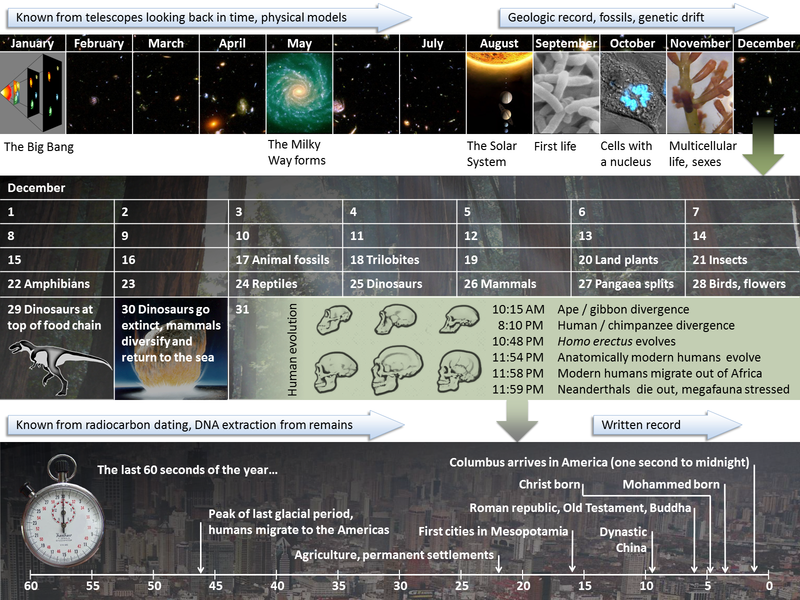Unless otherwise noted,
the material on this page may be used under the terms of a
Creative Commons License.
| Deep Time | ||
| Time | Cosmic Calendar |
| Logarithmic Timescale | Palaeos home | Time | Deep Time | Timescales |
| Palaeos home | Geological Time | Historical Time | Cosmological time Timescales |
Cosmic Evolution Sister Unit |

Editor's note: The text on this page is from Wikipedia, apart from one or two light edits, taken verbatim because their presentation looks as good as any, and I can't be bothered reinventing the wheel. The main difference is colour coding according to eras and so on. MAK110824, 110917
The Cosmic Calendar is a scale in which the 13.7 billion year lifetime of the universe is mapped onto a single year. This image helps to put cosmology, evolution, and written history in context. At this scale the Big Bang took place on January 1 at midnight, and the current time is mapped to December 31 at midnight. At this scale, there are 434 years per second, 1.57 million years per hour, and 37.7 million years per day. The concept was popularized by Carl Sagan in his book The Dragons of Eden and on his television series Cosmos as a way to conceptualize the vast amounts of time in the history of the universe.
The following includes Cosmological time and the start of Geological Time (Chaotian and Hadean).
| Date / time | bya | Event |
| 1 Jan | 13.7 | Big Bang, as seen through cosmic background radiation |
| 11 May | 8.8 | Milky Way Galaxy formed |
| 1 Sep | 4.57 | Sun formed (planets and Earth's moon soon thereafter) |
| 16 Sep | 4.0 | Oldest rocks known on Earth |
| Date / time | bya | Event |
| 21 Sep | 3.8 | first life (prokaryotes) |
| 12 Oct | 3 | photosynthesis |
| 29 Oct | 2.4 | Oxygenation of atmosphere |
| 8 Nov | 2 | complex cells (eukaryotes) |
| 5 Dec | 1 | first multicellular life |
| 14 Dec | 0.67 | simple animals |
| 14 Dec | 0.55 | arthropods (ancestors of insects, arachnids) |
| 18 Dec | 0.5 | fish and proto-amphibians |
| 20 Dec | 0.45 | land plants |
| 21 Dec | 0.4 | insects and seeds |
| 22 Dec | 0.36 | amphibians |
| 23 Dec | 0.3 | reptiles |
| 26 Dec | 0.2 | mammals |
| 27 Dec | 0.15 | birds |
| 28 Dec | 0.13 | flowers |
| 30 Dec | 0.065 | K-T mass extinction, non-avian dinosaurs die out |
The following continues with Geological Time, which then becomes Quaternary Time.
| Date / time | mya | Event |
| 30 Dec | 65 | Primates |
| 31 Dec, 06:05 | 15 | Apes |
| 31 Dec, 14:24 | 15 | hominids |
| 31 Dec, 22:24 | 2.5 | primitive humans and stone tools |
| 31 Dec, 23:44 | 0.4 | Domestication of fire |
| 31 Dec, 23:52 | 0.2 | Anatomically modern humans |
| 31 Dec, 23:55 | 0.11 | Beginning of most recent glacial period |
| 31 Dec, 23:58 | 0.035 | sculpture and painting |
| 31 Dec, 23:59:32 | 0.012 | Agriculture |
The remainder of the calender pertains to Historical Time.
| Date / time | kya | Event |
| 31 Dec, 23:59:47 | 5.5 | First writing (marks end of prehistory and beginning of history), beginning of the Bronze Age |
| 31 Dec, 23:59:48 | 5.0 | First dynasty of Egypt, Early Dynastic period in Sumer, Astronomy |
| 31 Dec, 23:59:49 | 4.5 | Alphabet, Akkadian Empire, Wheel |
| 31 Dec, 23:59:51 | 4.0 | Code of Hammurabi, Middle Kingdom of Egypt |
| 31 Dec, 23:59:52 | 3.5 | Mycenaean Greece; Olmec civilization; Iron Age in Near East, India, and Europe; founding of Carthage |
| 31 Dec, 23:59:53 | 3.0 | Kingdom of Israel, ancient Olympic games |
| 31 Dec, 23:59:54 | 2.5 | Buddha, Confucius, Qin Dynasty, Classical Greece, Ashokan Empire, Vedas completed, Euclidean geometry, Archimedean physics, Roman Republic |
| 31 Dec, 23:59:55 | 2.0 | Ptolemaic astronomy, Roman Empire, Christ, invention of numeral 0 |
| 31 Dec, 23:59:56 | 1.5 | Muhammad, Maya civilization, Song Dynasty, rise of Byzantine Empire |
| 31 Dec, 23:59:58 | 1.0 | Mongol Empire, Crusades, Christopher Columbus voyages to the Americas, Renaissance in Europe |
| Date / time | kya | Event |
| 31 Dec, 23:59:59 | 0.5 | modern science and technology, American Revolution, French revolution, World War I, World War II, Apollo Moon landing |
In contrast with the logarithmic and cosmological timelines, each successive time unit, each day or minute of the cosmic calendar, is the same length. Nevertheless, anthropocentric bias and the general anthropic perspective is still evident in the way that more and more events are crowded into the last minutes and seconds (ultimately, a logarithmic view of history and deep time is unavoidable). Inevitably, deep time requires several different timescales between cosmological time (here, the first eight or nine months) and archeological and historical time (the last 15 seconds or so of the cosmic calendar). MAK110824
| Logarithmic Timescale | Time | Timescales |
last modified MAK110917, edited RFVS111109